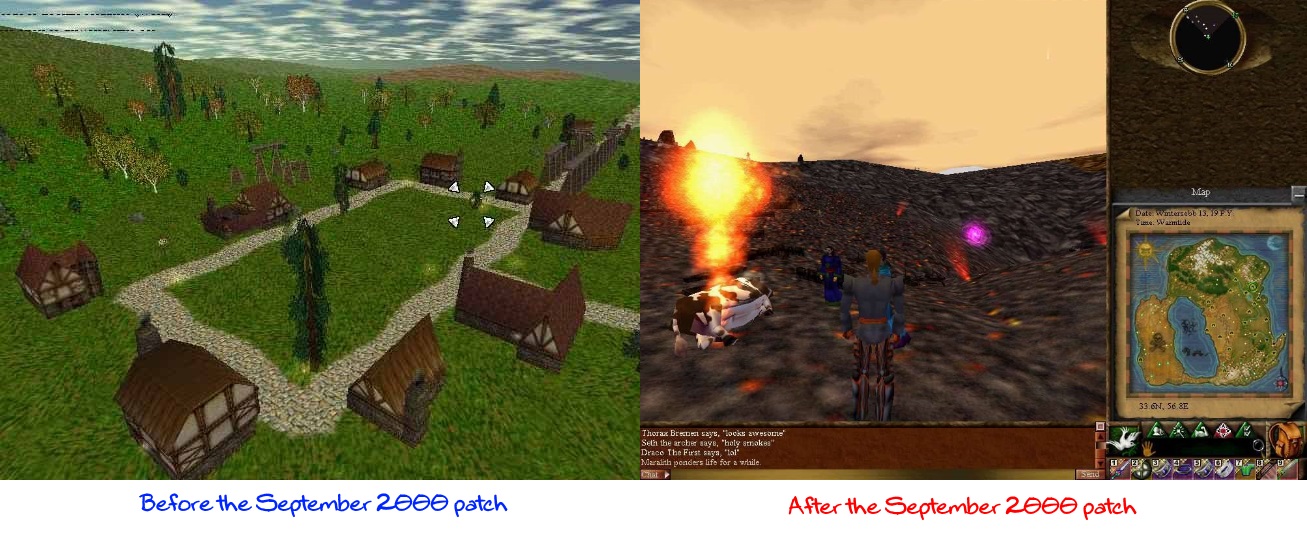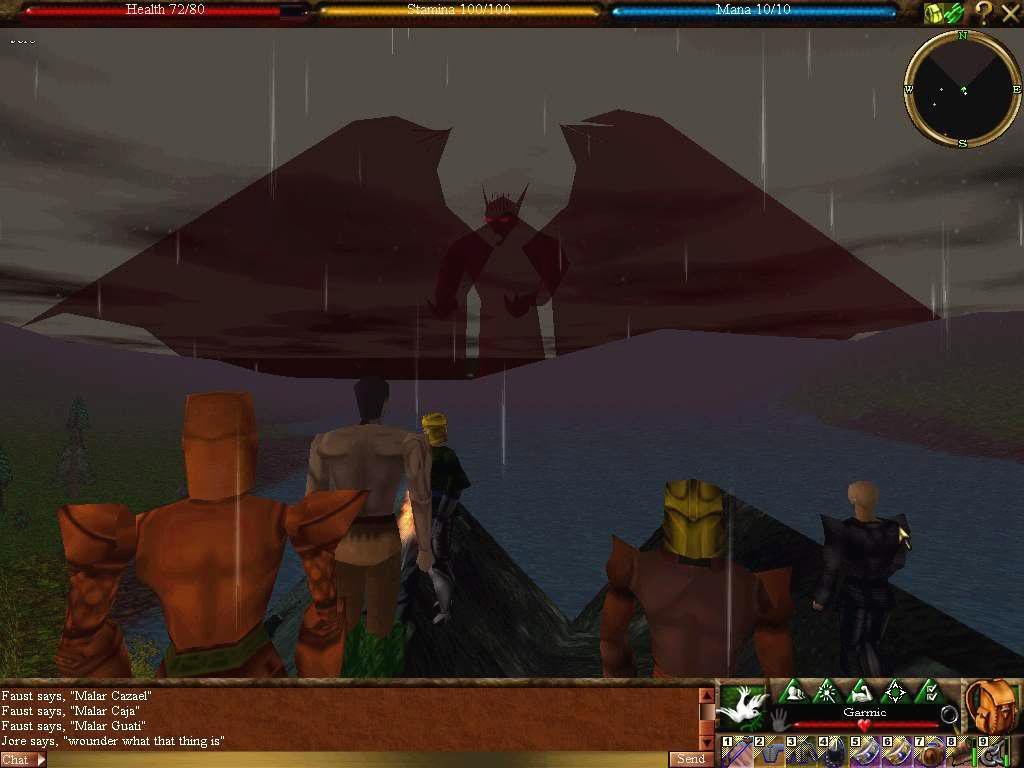
Although the Asheron’s Call series has now been dead for exactly one year today, it’s far from forgotten by fans. It was admittedly a cult classic, and as the youngest of the “Big Three” graphical MMOs, it was the easiest to ignore, especially as it used an original sci-fi/fantasy setting rather than, well, something with elves.
MMO AC converts I’ve met regularly said the game was more solo-friendly and more story-driven than Ultima Online and EverQuest, receiving monthly updates that felt like downloadable content before DLC was a common industry term. These weren’t simply automated addons but events that were often curated in a fashion that is similar to Game Masters in tabletop RPGs, meaning that those who built the scenario sometimes participated as their own lore characters, placing themselves at the mercy of their own game and community. While several events in both AC1 and AC2 made use of this kind of interactive story-telling style, none is better recalled than the first event: The Shard of the Herald.
There’s a bit of a problem though: Most industry vets and bloggers who write about it didn’t actually participate in it. We have some neat blurbs and even a tell-all forum post about the behind-the-scenes player-plotting, but these don’t adequately describe the event as normal players experienced it, nor do they discuss what they mean to the genre. As I was not only active in the game and on the server it took place on, I actually indirectly aided the defenders in a critical role: pizza delivery boy.
Experiencing the story build up
What most write-ups on the event don’t acknowledge is that the Shard of the Herald event wasn’t something that randomly popped up; it was a year-long story arc. For years, each month in Asheron’s Call received an actual content update, not just bug fixes. The first arc was known as the Fourth Sending of Darkness, revolving around a certain faction primarily defined through mobs called “Shadows,” creatures who had encountered a sentient chaos that had corrupted them with or without their assistance. It might be easy to think of them like Judeo-Christian demons.
When the game launched, players got a new location, Frore, which hinted at a long-lost darkness the undead Frorians were trying to keep hidden. Specifically, it was hinted that living crystals were containing some dark power. Players, naturally, destroyed the crystal, despite its ominous name: The Great Work. Lore collected through the experience (which was translated in-game via NPCs) strongly hinted that players had destroyed something containing an evil they were not supposed to know.
Sadly, as the lore was delivered not just through text but delivery quests with little-known NPCs, the significance was lost on many, and this was a pattern that would repeat itself over and over. This habit of tying lore, found both on the company website and through in-game documents that needed to be translated by very specific NPCs, continued for most of the game’s lifetime. And unlike the World of Warcraft era of MMOs, back then there were few MMO websites to disseminate information as they do today.
Toward the middle of the Fourth Sending, Turbine dropped stronger, visual hints at who was on which side. Dungeons might have bodies of one faction dead or dying while the opposing force would not only be left standing but (via text) still communicating story hints to the players. Sadly, few players, especially those at the highest levels, paid attention or considered their actions. New content often had some “server first” reward, and players primarily focused on this. When one update suddenly added a strange, demonic visage after lightning flashed, players began questioning what they saw, but didn’t really make any connections with to the story unfolding around them.
The content wasn’t just automated, though. The Gauntlet was an invite-only GM event. GMs, roleplaying the forces of darkness, challenged high-ranked leaders on each server to survive an ordeal to prove their loyalty to the yet unknown evil. Few people knew who on their server was chosen, as some monarchs resisted the call and refused to ally with evil. As a casual player, I didn’t even know about this event until months later. I only knew that there were very few people with smoky black weapons awarded by the event. While those monarchs who rejected the call didn’t receive any equip-able rewards, later events would grant them an audience with a GM-controlled Asheron, allowing them to roleplay with the character before a major live event would be revealed. In fact, the results of the event would prove key to the story arc’s resolution for the Thistledown server.
The bads started winning
Eventually, the war got “hot.” Shadows began to actually invade towns and slew shoppers. At the last town defense battle, there was an announcement from a slain Shadow leader that one of the Shadow generals had failed to show up, but it didn’t seem important at the time. More than the lore, though, for a normal player who hadn’t been able to get inside the event dungeons, I remember the drama surrounding the unique reward dropped by the named boss mob at the climax of the event. It felt like the Fourth Sending was over and that we’d won. We were wrong though. Very, very wrong.
Upon logging into the September 2000 event, we realized several towns had been annihilated by the Shadows. The town of Arwic, essentially Orgrimmar or Stormwind in World of Warcraft, was left a smoldering crater with almost nothing but a few clues about the attacker, a dead cow, and an NPC selling counterfeit goods. There was a practical reason for this, but as a player, I just remember being confused about where to go for trading, as there was no trade channel, auction houses, or mail system. Players gathered in a nearby dungeon primarily used for fast travel, as it was one of the main reasons the town had been so populated, but confusion abounded.
Combined with a red meteor in the sky, it really seemed as if something big was happening. People were left homeless. Guilds (known as “Monarchies” or “Allegiances”) didn’t have in-game chat channels, so physical meeting locations were important. The threat of losing towns without being able to fight back felt unfair but also exciting. Lore-wise, we’d heard that a few famous characters had stopped two of the attacks, including Asheron himself. Near the end of the month, three unique dungeons opened.
The first included corpses of both Shadows and Undead, an apparent attempt to show that the two were fighting. Players simply were picking off survivors. No one realized that Isin Dule, the traitorous Shadow General from the earlier invasions, had sent his Shadows to defend the second crystal. The third crystal, protected by the Undead faction, should have hinted that they were also trying to protect the damn thing, but alas, this too was missed. Most people simply saw content and ran to complete it. Again, because the game gave unique rewards to the first people who finished certain content, everyone wanted to be “that guy.” I don’t think anyone questioned whether or not the three new named crystals should be destroyed, and naturally, they were. “Black laughter” was heard as each crystal fell. We were sealing our own fate.
Life during the Shard Defense
The November event, “Should the Stars Fall,” set an ominous tone for the coming weeks. Players had to go through a bit of a process to access the final crystal, “The Shard of the Herald.” Sure enough, the death of the final shard summoned the AC equivalent of Satan, complete with a Baphomet like appearance.
Many servers destroyed the shard the first day of the event. Again, players had been taught that killing something or doing content led to equip-able rewards, while opting out seemingly meant you lost an opportunity. Few of us knew that someone was taking advantage of a bug, but just the same, all eyes were on Thistledown, a single server that was potentially taking the game’s previously uniform lore hostage.
And that was exciting. My classmates who played on different servers were intrigued. Though the day to day activities of the Shard Defense didn’t really affect other servers beyond the vague notion that the story could possibly be splintered, Thistledown briefly changed in some subtle ways.
The first thing that happened was you’d occasionally see a death message that someone had died to The Shard of the Herald. Player deaths caused a local announcement, often with fun dialogue. During the event, this was how several of us found out about one of the defenders’ tactics: sacrificing themselves to the shard.
Unlike mobs in most MMOs, AC’s creatures could level up by killing players. It was an interesting feature, as powerful mobs would become more threatening, requiring higher-level players or additional coordination in order to defeat them. It also was good for a laugh, as bored players might level up newbie mobs, like a rabbit or cow, and watch as the mob wrecked unassuming lowbies. On Harry, the shard, it was a key defense strategy.
During the event, however, certain names would continue to pop up. They were usually identified as Shard Defenders. If a group of people had died to the shard, they were assumed to be attackers. Many people were rooting for the defenders, but others worried our defense would prevent the developers from giving us our next update. In fact, at school, people started telling me that I should help kill the shard so that the next event wouldn’t get “messed up.”

This wasn’t very easy though. Because of the previously mentioned bug and lack of public explanation of the event, regular players PMing shard attackers/defenders were often ignored if they asked about how to directly help out. Often, those involved would change their spawn location so they could help level up the shard without the threat of being discovered, not just because of the death message but to hide their access method to the dungeon. I remember finding one such person in the middle of nowhere, who was willing to chat a bit, but he or she was fairly secretive. All I’d learned was that, yes, people were leveling the shard, that certain allegiances were involved, and that few people were invited to directly participate in the defense. Eventually, however, I found out how some of us had been indirectly helping the defense.
While some people were sacrificing themselves to the shard, others were literally protecting it. Raids at 3 a.m. were not unheard of. The shard’s dungeon had other ways of protecting it, such as other mobs, traps, and switches to slow people’s progress. As the dungeon legitimately required a process to access it or a special cheaty method to return to it, neither side really wanted to leave the dungeon.
My path to pizza delivery boy
During the shard defense, I’d noticed more people leveled cooking and alchemy. People were asking to buy more consumables than usual. In fact, I’d made a character to cash in on the new market, but didn’t work on it seriously. My “patron” (the guild member who recruited me) had a friend who had been making some high-level foods. It wasn’t her main character and primarily leveled up through the game’s experience point pyramid scheme, so while the character was skilled at crafting, it was horribly weak. After she’d tried fighting with it one night and finding just how weak it was, she recruited me for a special assignment: pizza deliveries.
For several days, I’d come to her safe location. She’d give me more pizzas than any reasonable player would need, then summon a portal. I’d go through that portal, run to certain coordinates, and trade pizzas for cash. It was kind of in the middle of nowhere, and I was never offered a portal back.
However, one day, while I was coming back with the money, there was another delivery man. I knew several of the monarchs who were supporting the effort, but this guy was in an allegiance that tended to be self-serving unless you were a fellow power player – and he was flagged for PvP. Our allegiance was inactive in PvP and much smaller, more community-based. We didn’t tend to run in the same circles, so once he left, I’d asked why she’d been doing business with him. This was how I discovered that the pizzas we’d been making were for the shard defenders.
As shard defenders needed to physically be in the dungeon to protect it, they needed a lot of consumables. While certain supplies could be farmed from the right mobs, specialty food had to be crafted. Players could just buy NPC potions, but AC’s item management system included burden, meaning you wanted light, efficient items. Normally, specialty food and potions were too much of a hassle for most people to bother with, but the war effort suddenly created a demand for them, as well as non-PK delivery boys and girls who couldn’t be killed and looted. Not just pizzas and potions, but portals, key fragments (for those not abusing the bug), and probably more than I was aware of.
But the event did more than bolster the consumables industry. It helped the RP scene. While I believe the Frostfell server was the unofficial RP server, there were some roleplayers on Thistledown. In fact, one of the defenders, Blackjack, would write his side of the defense story through an RP tale. While my patron would often complain that her friends liked to sit around and talk a little too often, RPers occasionally stumbled into our meetings and spiced things up during the defense days. We’d trade rumors and occasionally dig through in-game notes we’d received from quests to learn more about what had been happening. I remember a friend and I’d started randomly RPing, and it was something he’d never done before.
Monarchs (guild leaders) working directly with attackers and defenders had their lives changed, in and out of game. Fafhrd, one of the more involved shard defenders listed on the memorial and a non-PK RPer, told me via Reddit how “the chat interface made it very hard for [him] at times to really just play,” as AC didn’t have guild chat, mostly just private messages or announcements akin to a text loudspeaker system. He mostly remembers “a wall of words” when it comes to the event, but he also mentioned how people were (obviously) sleeping less, to ensure constant defense (or for attackers, a possible opportunity to avoid the defense).
In the end, the shard fell. The full details are discussed in a developer written letter to the players, but essentially, the devs used the roleplay set up and game lore to intervene. Though two players had participated in the Monarch Gauntlet event to show loyalty to the Hopeslayer, only one answered the call: Vidorian. Developers, using powered up lore characters, helped Vid into the dungeon to slay Harry. This was complicated by several bugs though, including one where Harry refused commands to scale down, leading to jokes that he’d gain sentience. Players killed the devs/lore characters as well as Vidorian, but were eventually defeated. The servers would once again have a united story-line, but Thistledown’s defense seemed to create a canonical addition to the mostly dev-driven lore up to that point.
MMO significance
Unfortunately, we don’t see a lot of game lore today that’s based on player action, outside of EVE. Long ago, Horizons/Istaria had both GMs playing in the game-world and community events to unlock new races. Guild Wars 2 included some with events like its Cutthroat Politics event, and Elite Dangerous is really making progress in this area (and Senior Designer Sandy Sammarco played the game a bit and remembered a bit of the event). Ultima Online allowed players to determine the fate of the city of Moonglow during a multi-year invasion arc. A few others have talked about including this kind of play (RIP Revival, good luck Chronicles of Elyria!), but I feel few learned some important lessons from AC’s handling of the Shard event.
For me, the takeaway was that having an outcome based on player events got the community fired up, but they needed more obvious storytelling to understand what was at stake. Having unique rewards, especially for server-first kills, trained players to mindlessly kill, especially because up until Turbine made the statue in honor of the defenders, not-killing never got rewarded.
The Shard of the Herald is one of the big historical MMO moments because developers gave players control over their fates, and while most ignored it, a small organized group figured out the weight of their choices and embraced the lore. The developers hadn’t exactly given them the support they needed, but with the help of some features and bugs Turbine went on to remove, they were able to make due. With any luck, future MMO events will be able to look into the work Turbine did, simplify and enhance the storytelling, but perhaps focus rewards on both sides of the outcomes for all players, not just the ones directly involved in the highest levels of content.


















